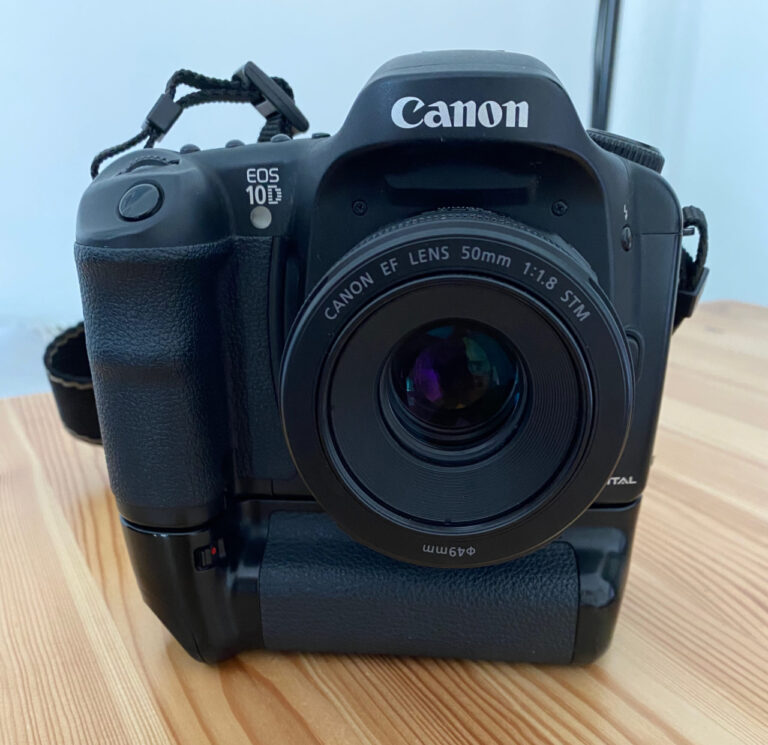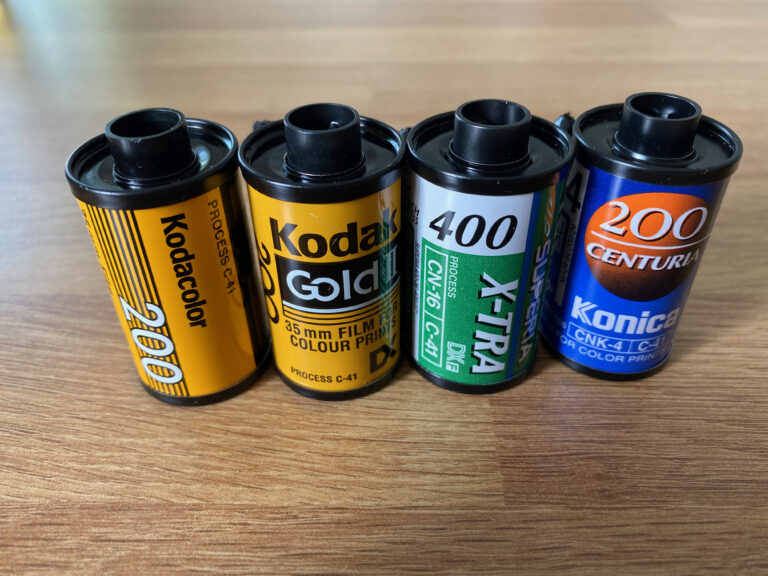Whilst in the loft trying to dig out suitcases I had one of those “I wonder what’s in this box?” moments. Without fail, when you move house there always seems to be a box or two that end up on a permanent “I’ll sort that later when everything else is in order” list. Those boxes then find their way into the bottom of wardrobes, cupboards or up in the loft. This was one of those boxes, untouched for over a decade and full of bits and pieces that we hadn’t immediately needed for one reason or another. I opened it to find a treasure trove of things I’d lost and had been looking for.
In this box were two light meters, a range finder for my Voigtlander Bessa (the location of which has been driving me nuts for months) and my Grandad’s old Kodak Retinette 1A in its brown leather case. This was quite the discovery, I didn’t recall ever having this particular camera and hadn’t expected to unearth it in a box in the loft. Old Kodak film cameras are everywhere, they must have sold millions of them over the years because you cannot walk into a junk, antiques or thrift shop without seeing at least a Brownie of some description looking rather sorry for itself. I’ve never had a particular reason to use one before, but here was the perfect opportunity to discover what owning a Kodak in 1960 was like.
In this post:
The Retinette series

I don’t mind admitting that it took me a long time to truly understand film cameras. My initial interest in photography in the early 2000’s was firmly entrenched in the digital world and despite buying an AE-1 Program in 2007 and inheriting a medium format Voigtlander Bessa, I didn’t really know what I was doing and certainly came at it from the wrong angle. I’d been spoiled by the sheer convenience and performance of digital, so when confronted with a fully manual film camera that I had zero understanding and experience of, I’m afraid to say my reaction was “what’s the point in that?”
But we all grow up, right?
This is how the Retinette ended up in a storage box. You don’t inherit a camera and then donate it to charity shop – I did have the foresight to know that it was something I’d use later on, when I’d learned what I was doing. It’s the camera enthusiasts equivalent of your dad’s “good bit of wood” pile in the garage – you have no idea whatsoever why you’re keeping all those offcuts, but you know one day you might just need that particular bit and God forbid you throw it out because the day you needed that particular piece of wood will then be tomorrow.
The rigid body (there were a few foldable) Kodak Retinette series saw countless iterations and most of them were minor in nature, perhaps a slight change in body shape or a variation in the shutter mechanism used. From the information I can find on Camera-Wiki and other sources such as the excellent Retina Rescue, the Retinette I have is an early Type 035 Vero shutter variant made in 1959. According to the serial numbers, 78,702 of these particular Retinettes were produced, although many hundreds of thousands of Retinette 1A’s of all types were manufactured over a six or seven year period.

Retinettes were meant to be cheap(er), simple, compact travel cameras that could be operated by nearly everyone and taken nearly anywhere. At first glance you might think that a completely manual camera without the ability to focus through the viewfinder might not be all that easy to use, but it is. In 1959 expectations of users were very different and it was almost a certainty that people would carefully read the manual before using their new toy, this meant that manufacturers could at least convey the basics. I have no doubt that many rolls of films still came back with disappointing prints, though!
Film is so forgiving that as long as you are in the right ballpark with an exposure, you will get something out of it. This is probably the key to these kinds of cameras in that you can pretty much walk around at f11 all day and be ok. It is surprising how quickly you get used to taking a meter reading and then just clicking up or down a stop as conditions change around you – a method that works 90% of the time quite reliably. Exposure is only one side of the coin, though, and it is telling that the later variant of the Retinette 1A changed the distance scale on the lens to include visual cues for different distances such as mountains and groups of people.
As the Retinette range matured the incremental upgrades saw these small cameras become more and more capable. Over time, Retinettes gained selenium cell meters (Retinette II) and eventually coupled meters (Retinette 1B) to set the aperture automatically based on a meter reading. A rangefinder would probably have made these later models almost foolproof.
A Retinette road trip

I loaded the camera with a roll of Foma 400 and took it out on a number of walks around the historic Medieval village of Dunster, near Minehead. Dunster is a quirky, beautiful village with plenty of history and a place where no two buildings are the same. Tourism is huge there but this was never a place designed for cars to drive through, footpaths are nonexistent in some parts of the village so you have to be careful when framing a photograph of an interesting building as invariably a delivery lorry will suddenly appear round the corner!
This setting was perfect territory for the Retinette and is exactly what these cameras were designed for – holiday snaps. For two days the weather seemed to be F11-F16 at 1/250 or 1/125 no matter where I went. As I mentioned earlier, I very quickly adapted to adjusting either aperture or shutter speed a stop here or there depending on how the light had changed rather than reverting to constant metering, although I did meter each significantly new place to ensure I had a reasonable base reading.
Rather than try to guess the rough distance to an object, I reverted to using the hyper-focal distances instead. At F11 you can get everything between about 8ft to infinity in focus and at F16 it’s roughly 6ft to infinity. These ranges seemed perfect for the street and landscape type photographs I was taking. There were occasions when I tried some close up portraits but more often than not these were both indoor, low light and at slower shutter speeds like 1/60th where camera shake creeps in. As such, guessing the distance accurately is essential as your depth of field is really rather limited at F3.5 – these closer shots tended to come out soft, sadly.

Other than that, the Retinette is a joy to use. It has a well weighted shutter release, although I’d think twice before stashing it in a pocket or bag as there is nothing to stop you triggering it if the film has been wound on. Mine comes with the almost ubiquitous brown leather hard case that cameras were sold with in that era and I’d say it’s an essential piece of kit because it protects the shutter from being accidentally triggered when in a bag or similar.
The film advance lever, despite being plastic, feels very smooth and easy to use. The lever is unusually placed at the bottom of the body and whilst this may sound unnatural it proved to be anything but and I found it quite convenient. The film advance is among the lightest and easiest I’ve ever experienced on a camera. So much so that I’m glad I put a test roll in at first because initially I wasn’t convinced that the film was even advancing, the action is lighter than any SLR I’ve ever used and I’m really not sure how they managed it.
As you may expect from an entirely mechanical camera, in use the Retinette is effectively silent. The shutter makes the most imperceptible click when released and the advance as we know is equally refined. This makes for a very small, discrete camera that doesn’t interfere in quiet settings or when discretion is called for. I don’t recall anyone noticing that I was using it, other than the occasional glance when people realise you’re not using a digital camera.
Issues

Using a camera to take pictures is one thing, whether those pictures actually come out of the camera as you’d expect is another. I genuinely loved using the Retinette as a holiday camera, it brought back a lot of the joy and simplification that can be found with film photography – just walking around finding things to photograph with no particular agenda or theme to fulfil. For this kind of photography, I think it is perfect – it’s got enough of what you need and nothing you don’t.
However, no camera is perfect and I did discover a couple of quirks. Most strange of all was the presence of some fairly reasonable light leaks on my second roll of film. There are no signs of this on the first roll, and it affected 3-4 frames at the start of the second. I really am not sure why this happened as the camera obviously doesn’t have a light leak (it’d be on all frames and would’ve affected both rolls) and I can only conclude that I did something to the film during either loading or rewinding that ruined the shots as you can see above. What I did wrong, I cannot tell.
For a compact camera from the 1950’s, the lens is acceptably sharp but does have some quite noticeable vignette in certain conditions. Edges of the frame can be soft and I think my shutter is in need of a clean as there were one or two frames that didn’t look quite right when shot at the very lowest speed of 1/30th. The higher the shutter speed, the snappier and more accurate the shutter feels. This is definitely to be expected in a camera of this age and I’m not in the least bit surprised that the shutter may not be accurate any more. I can, however, say with complete certainty that this lens is light years ahead of the utterly awful lens I used recently on the Exa 1a…

Finally, for close up work you absolutely cannot rely on the “ballpark” focussing that I used in most situations. Anything from roughly 3-10ft away from the camera needs to be judged with an excellent degree of accuracy with the focus set to almost the exact distance to the subject to achieve a sharp image. This isn’t a fault of the camera, it’s physics. Set to the correct distance it does produce sharp pictures, and this is a difficulty faced by all users of all cameras without a rangefinder or through the lens focussing. You either guess and get lucky or over time develop an intuitive ability to judge distance – or suffer blurred results.
To put the close focus dilemma in context, according to the distance scale on the lens if you shot at F3.5, you have a depth of field of…. 6 inches. That’s not something you’re likely to judge well just by eye! Over two rolls, it was only at the very end of the last roll that I began to get better at close up shots and even then some bracketing work showed how unforgiving it can be if you misjudge a distance.
Conclusions

This isn’t exactly the most objective review of a camera I’ve ever carried out. In the harsh second hand world of eBay, Retinette’s are undesirable, cheap as chips old cameras that don’t demand anywhere near high or collector prices. The lens is good but not blow your socks off amazing and the range of available shutter speeds is adequate – a 1/500th option would really help in some lighting conditions. But this isn’t an eBay special, it’s effectively a family treasure and with that connection comes a natural affinity to the camera and that feeling that you’re using something really quite special.
As such, I can’t really give an unbiased opinion, but I am fairly certain that my observations are at least reasonable! There are definitely collectors of Kodak’s and Retina/Retinettes in general and I can see why, they have a certain charm to them. For a 35mm compact camera from the 1950’s they’re well thought out, build quality is good (although apparently some do have plastic wind levers which fall off).
A lot of people worry about not having a light meter on their camera but in all honesty it’s just not necessary with phones that can act as pretty accurate light meters and the sheer latitude that black and white film offers these days, you can get away with so many mistakes and still have an image (of sorts) after development.
The Retinette has a good quality lens and a “good enough” range of shutter speeds. It does miss out on a self timer which would definitely be useful for slower speed shots and the later models and variations do have this feature. The viewfinder is large, clear and I’d estimate 98% accurate from the results I achieved – the parallax correction frame is quite useful for closer shots. I’m sure that with a good strip down, clean and service my shutter speeds would be even more accurate but in all honesty I don’t have the confidence to do the job and not break something in the process. Whilst it works, it works.

So the only thing left to conclude is… should you buy one? I think the answer is a yes.
I’ve avoided this type of camera for quite some time now, for no good reason other than they didn’t really spark my interest. Having now spent some time with the Kodak, using it for the purpose it was designed for, I think they’re a real joy to use. They’re cameras that are pleasing to use because they’re well built, there’s no battery to run out and almost nothing that can go wrong with a working copy that has been well looked after and you get decent pictures out of it. What’s not to like?
The extra bonus is that these are not “collectable” at the moment, of course everything will become collectible as time goes on I’m sure. Now is definitely the right time to invest in a little piece of 1950’s history – stick one round your neck on your next holiday and go for the full experience of what it would’ve been like to holiday in the jet age. Ray Bans? Check. Best trousers, shirt and tie? Check. Small leather suitcase? Check. Retinette? Check. You’re ready for the skies, my friend!
Share this post:




